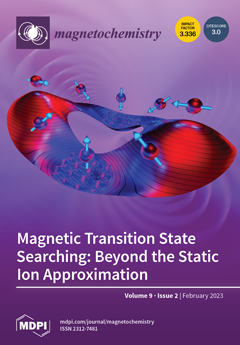Cyclic 3d-4f molecular magnets have received considerable attention owing to their potential applications in high-density data storage and quantum information processing. As a rare example of ferromagnetic polynuclear Cr rings, {Cr
8Y
8} represents a valuable test bed to directly study the magnetic interaction between Cr
3+ ions in large hexadecametallic {Cr
8Ln
8} (Ln = 4f metal) molecules. We have proposed a “single-
J” model to approximate the low-temperature spin dynamics of {Cr
8Y
8} in our earlier study, while a zero-field splitting (ZFS) of the quantum levels was also suggested by the heat capacity data. In order to have a deeper understanding of the magnetism of {Cr
8Y
8}, it is necessary to verify the ZFS by means of high-resolution spectral methods and identify its origin. In this work, we present a high-frequency electron spin resonance (HF-ESR) study on the ZFS of {Cr
8Y
8}. The X-band ESR spectra consists of multi-peak structure, indicative of magnetic anisotropy that breaks the degeneracy between spin states in the absence of a magnetic field. HF-ESR spectra are collected to extract the ZFS parameters. We observed a sharp resonance peak due to the transitions between the
S = 11 quantum levels and a broadband corresponding to a distribution of resonance peaks due to the ZFS of the
S = 12 quantum levels. By analyzing HF-ESR spectra, we confirm the expected
S = 12 ground state and determine its ZFS parameter
D as −0.069 K, and, furthermore, we reproduce the spectra recorded at 154 GHz. The macrospin model proves to still be valid. The ZFS is attributed to the axial magnetic anisotropy, as found in some other Cr-based molecular wheels. The detailed HF-ESR investigation presented in this paper will benefit the studies on other {Cr
8Ln
8} wheels with magnetic Ln
3+ ions and highlights the importance of the HF-ESR method as a high-resolution probe in determining the ZFS parameters with very small magnitude.
Full article





